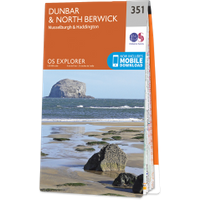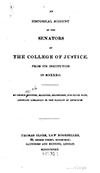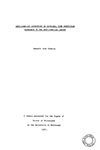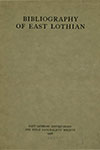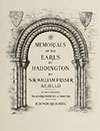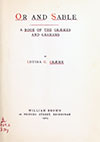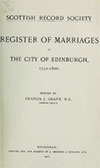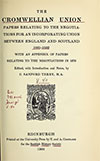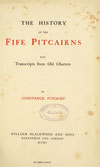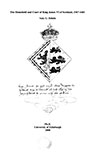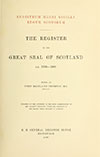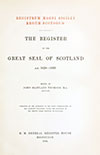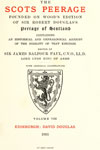

John Adair, 1682map image courtesy of NLS
Fenton Barns is marked on Adair’s map of 1682 as a tower or prominent house although today the site is occupied by a possibly late 17th century ruined farmhouse and a mid-19th century farmhouse. What form the earliest building took is not clear so for now I have listed it as a possible castle.
The early history of the site doesn’t seem to be known, it seemingly first appearing on record in the first half of the 16th century. The lands of Fentonbarns were part of the barony of Dirleton and so would have been owned by the de Vaux family from the 12th century.
Dirleton passed to the Haliburton family around 1350 when John Haliburton married the daughter of William de Vaux. In 1505 the last Haliburton owner of Dirleton, Patrick Haliburton, died, and his estates were divided between his three daughters.
Which sister received the third of the barony which included Fentonbarns I have not been able to ascertain. Dirleton Castle went to Janet, whom in 1515 married William Ruthven, the 2nd Lord Ruthven. Mariota married George Home, 4th Lord Home, before 1529, and Margaret married George Ker of Faldonside.
It may be that Fentonbarns passed to Mariota and Lord Home as in 1537 James Borthwick of Lochhill gave John Arthur and his wife, Helen Home, an annual rent of 30 merks from the half lands of Fentounbarns. In January 1583 “Adam Babdye in Fentounebarnis” was a witness to a land transaction between Edward Oliveir of West Fentoun and George Home, although whether or not this was Lord Home is unclear.
Some time in the last quarter of the 16th century the estate of Fentonbarns was bought by John Preston or Prestoun, the son of John Prestoun, an Edinburgh baker and town councillor, who may have been related to the Prestons of Craigmillar as he was a surety in a bond of caution by David Preston of Craigmillar.
Some sources state that he married firstly a daughter of Scott of Balwearie however his first wife was actually Elizabeth Fawside, widow of Clement Little of Liberton.
Following his wife’s death he married secondly Lilias Gilbert, the daughter of Michael Gilbert, an Edinburgh goldsmith and financier, in 1569. Preston studied law and became an advocate some time before October 1575. In 1580 he was a commissioner of Edinburgh, a post he held until 1599, and he also held the position of Clerk Register.
During the 1580s he witnessed various documents and in 1582, along with his father, also John, witnessed a sale to Walter Cant and his wife, Margaret Prestoun, of the lands of Sanctgeligrange by Thomas Cant of Sanctgeligrange.
He was elected to the Court of Session as Lord Fentonbarns in March 1595 and in 1596 bought the lands of Buitland and Buitlandhill (Butelands), in the lordship of Borthwick, and the lands of Newthorne (possibly Nenthorn) from James Borthwick, 7th Lord Borthwick.
In 1597 he was a Member of Parliament and from December 1598 until January 1602 he was Collector General of the King’s Augmentations. In February 1602, for his good service, he and his wife were granted the lands of Gutheris, with its mansion and charcoal, and the lands of Drum and Gilmertoun, with their fortalices, manors and charcoals, which Hugo Somerville of Drum and his wife, Margaret Hamilton, had resigned to them on the 6th of June 1601.
In December 1603 Lord Fentonbarns bought the lands and barony of Penicuik from Alexander Penicuik of Penicuik and in 1604 he and wife received a new grant of the lands and barony of Penicuik for his good service.
In 1606 an Act of Parliament granted to John Erskine, Earl of Mar, numerous lands including those of Barnis. This might suggest that Lord Fentonbarns held Fentonbarns from the owners of the superiority of Dirleton.
Lord Fentonbarns was appointed vice-president of the Court of Session in December 1607 and in June 1609 was appointed Lord President of the Court of Session, a position he would hold until his death. His second wife having died, by July 1609 he had married Margaret Collace, daughter of Robert Collace of Balnamoon.
James VI confirmed the Earl of Mar’s grant of Barnis in June 1610 however in November a third part of Dirleton, Halyburton and Lambden was united into the barony of Fenton Barns for Sir Thomas Erskine of of Gogar, Viscount of Fenton. Sir Thomas was a grandson of Mariota Haliburton and the 4th Lord Home and was rewarded for coming to the aid of James VI during the Gowrie Conspiracy of 1600.
The lands which included Fentonbarns seems to have been granted alternately to John Erskine, Earl of Mar, and Thomas Erskine, Earl of Kellie, as in April 1615 James VI confirmed the Act of Parliament from 1606 granting, for good service, to John, Earl of Mar, the various lands which included Barnis.
Lord Fentonbarns died in June 1616 and his eldest son, John, succeeded to the Penicuik estates. He was married to Elizabeth Turnbull, daughter of William Turnbull of Airdrie, and through her took possession of the lands of Auchie in Fife where he built a new mansion house, Prestonhall.
In August 1616 James VI gave a new grant to Thomas Erskine, Viscount of Fentoun, Lord Dirleton, of various lands in East Lothian including the lands of “Barnes alias Fentounbarnes” with the manor and freehold land in the east of Dirleton which was occupied by John Congiltoun. However in March 1617 James VI confirmed a charter by John, Earl of Mar, to Henry Erskine, his son by Mariam Stewart, of the same lands.
Sir John had several other children including Catherine or Katherine, who married firstly Robert Nairne of Muckersie and was mother to Robert Nairne, 1st Lord Nairne, and secondly John Morrison, Treasurer of Edinburgh, by whom she had Alexander Morrison of Prestoungrange.
Fentonbarns went to Sir John’s second son, Michael, who was granted his fathers lands of Gutteris, Gilmertoun and Drum and received charters of confirmation in his favour by Sir Thomas Erskine, Viscount Fenton, of the lands of Fentonbarns alias Barns, including Bellslands and Bissetslands.
In May 1621 Sir Michael, with the consent of his wife, Marion Hay, signed a contract with David MacCulloch, servant to Sir Thomas Hamilton, Earl of Melrose, to sell the lands of Goodtrees, Drum, Gilmerton, Barns, Bellis lands and Bisset lands to MacCulloch for the payment of 5000 merks. Sir Thomas, as Lord Binning and Byres, had succeeded Sir John Prestoun as Lord President of the Court of Session.
In May 1627 Viscount Fenton, by now 1st Earl of Kellie, sold the lands, lordship and barony of Fentoun which included “Barnes alias Fentounbarnes” with the manor and freehold land in the east of Dirleton which was occupied by John Congiltoun to his son-in-law, Alexander Morrison of Prestoungrange.
Sir Michael Preston of Fentonbarns was involved in a dispute with two brothers named Smith in Drem in February 1631. He killed one and severely wounded the other and was convicted and beheaded within a week.
In June 1631 James Maxwell of Innerweik was granted the lands, lordship and barony of Fentoun, including Fentounbarnes, which the Earl of Kellie, Lord Fentoun, his daughter, Lady Ann Seton and her husband, Alexander Morrison of Prestoungrange, had resigned.
James Maxwell of Innerwick and Sir Michael’s widow, Marion Hay, signed a contract in August 1643 granting her and her son, John Prestoun of Fentounbarns, the teinds of Fentonbarns, Bellislandis and Bissetislands. In June 1646 Maxwell signed a precept of clare constat in favour of Alexander Prestoun of Fentonbarnes as heir to John Prestoun of Fentounbarnes, his brother.
In March 1648 the lands of Fentonbarns alias Barns, including Bellslands and Bissetslands, were resigned by David MacCulloch of Guilteris and Alexander Foullis, son of George Foullis of Ravilstoun, in favour of Alexander Prestoun of Fentonbarns. Later that year Alexander wadset the same lands to his sister, Mariota or Marion Prestoun, and brother-in-law, Andrew Couper, son of the late William Couper, Bishop of Galloway.
Alexander was dead by March 1649 when his sister, Marion, was served as his heir and received the lands of Barnes, called Fentounbarnes, the 6 pound 4 shilling husband lands of Bellislandis and Bissitslands, and the 6 shilling 4 pence husband lands in the territory of Eist Fentoun.
In 1652 Andrew Coryser of Fentonbarnes signed a document by Haddingtonshire heritors in support of Scotland joining Oliver Cromwell’s Commonwealth. It may be that this was a transcription error for Andrew Couper.
In 1663 when the advocate Sir John Nisbet bought Dirleton Castle and numerous other properties in East Lothian these included “the lands of Barns, otherwise called Fentounbarns, with the maner place, houses, bigings, parts, pendicles, tofts, crofts therof and their pertinents”.
It seems to have been the superiority of Fentonbarnes that Sir John bought as Marion Prestoun seems to have retained some rights over the property. In 1666 she, wadset the lands of Fentonbarns alias Barns, including Bellslands and Bissetslands, to Thomas Donaldsone, minister at Smailholm. Later there were writs of annualrents from the same lands in favour of James Dick, a merchant burgess of Edinburgh, and a heritable bond by Marion to Robert Thomsone, eldest son of the late Robert Thomsone, described as a skipper in Prestounpannes.
Andrew Couper died in 1674 and was buried at Greyfriars kirkyard in Edinburgh. The following year his son with Marion, William Couper, as heir received the lands of Fentonbarns alias Barns, including Bellslands and Bissetslands. In 1676 sold the same lands to Sir John Nisbet.
It may be around this time that a new house was built. At Fenton Barns there are the substantial ruins of a possible late 17th or early 18th century house, built on an L-plan with walls approximately 0.7m thick. Whether this is the house that Adair recorded or a successor is not clear.
By the 1690s the Yuill, Yule or Youll family were tenants, with George Yuill on record “in Fentounbarns” in 1694. They seem to have held the tenancy for several decades as they are on record in the 1740s and a presumably later George Yule was described as the tenant of Fenton Barns when he died in 1778.
In 1796 Robert Hope leased the farms of Fenton and Fenton Barns from William Hamilton Nisbet of Dirleton, having moved from Ferrygate, another farm on the Dirleton estate. Robert died in 1801 and his second wife remained at Fenton Barns with her family.
Robert’s second son from his first marriage, also Robert, took over the farm at Fenton and married Christian Borgue, daughter of George Borgue, a farmer at Stevenson Mains. Their second son, George Hope, was born in 1811. In 1820 Robert’s half-brother, who occupied Fenton Barns, died and Hamilton Nisbet convinced Robert to take on that farm too despite Robert struggling to make a living.
By the late 1820s George Hope was working in Haddington in the offices of a lawyer but returned home to take over the farm at Fenton Barns. In the late 1830s and early 1840s he was involved with the Anti-Corn Law League, striving for better rights for tenant farmers. He went on to become a leading agriculturalist who developed Fenton Barns into what was considered at the time to be a model farm using progressive farming techniques.
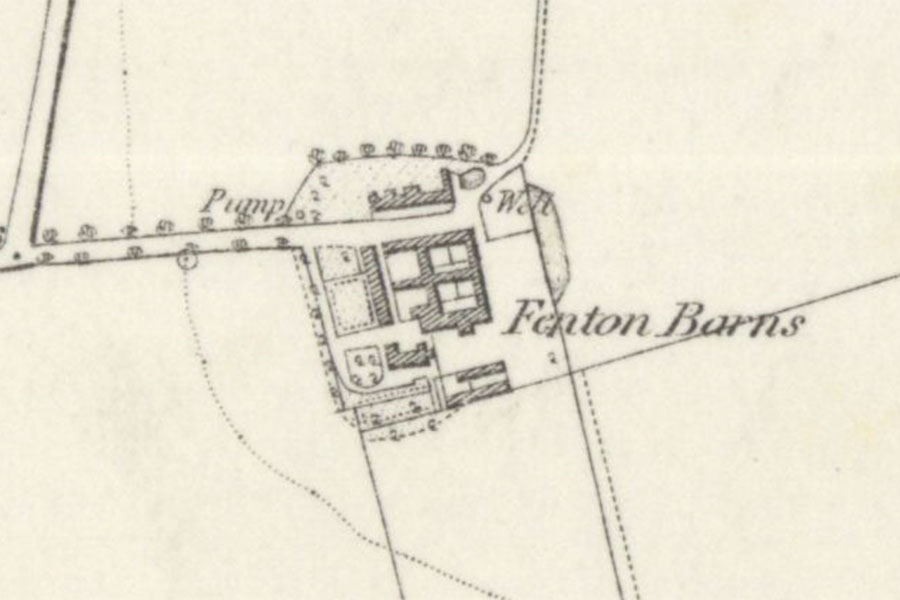
Ordnance Survey, 1854map image courtesy of NLS
In 1865 George Hope stood against Francis Charteris, Lord Elcho and son of the Earl of Wemyss, as the Liberal candidate for Haddingtonshire, but failed to be elected. He was informed by Mr Nisbet Hamilton and Lady Mary in 1872 that his lease of Fenton Barns would not be renewed, probably due to his political agitation. This news made headlines across Britain such was the esteem George was held in, and attracted letters of support from Europe. In the autumn of that year George bought the estate of Bordlands in Peeblesshire and moved there in 1873.
It may be around this time that a new house was built at Fenton Barns to the south of the old house. The house is described as mid-19th century in style but isn’t marked on the Ordnance Survey map of 1854. Rubble-built with ashlar dressings it features a symmetrical three bay classically-detailed south elevation and is two storeys in height. The house was later extended with the addition of a two storey wing projecting north from its west end to form an L-plan. A farm steading was built immediately to the north of the old house in the 1870s.

Ordnance Survey, 1894map image courtesy of NLS
The old house doesn’t have any features associated with a defensible building and would appear to be of too late a date. If there ever was a tower at Fentonbarns then it may have been incorporated into the 19th century house or cleared away when the farm steading was built. I will leave this as a possible castle site, centred on the 19th century house, pending further research.
During the first quarter of the 20th century Fentonbarns was owned or occupied by James P. Glendinning, a farmer, and the old house was used as a farm office. From 1923 or 1924 Fentonbarns was occupied by D.Chalmers-Watson, a farmer. When the Newbyth estate was broken up in 1946 some of the land was bought by Irvine Chalmers-Watson from Fenton Barns who built a new Newbyth House in 1949.
The old house at Fentonbarns was later used as a hatchery, by which time all of its internal walls had been removed along with its roof and the building is now an ivy-clad ruin.
Alternative names for Fenton Barns
Barnes; Barnis; Barns; Fentin bairnes; Fenton Barnes; Fenton Barnis; Fenton-barns; Fentonbarnes; Fentonbarns; Fentoun Barnes; Fentoun Barnis; Fentoun Barns; Fentoun-barnes; Fentoun-Barns; Fentounbarnes; Fentounbarnis; Fentounbarns; Fentoune-Barnis; Fentounebarnes; Fentounebarnis; Fountainbarnis


